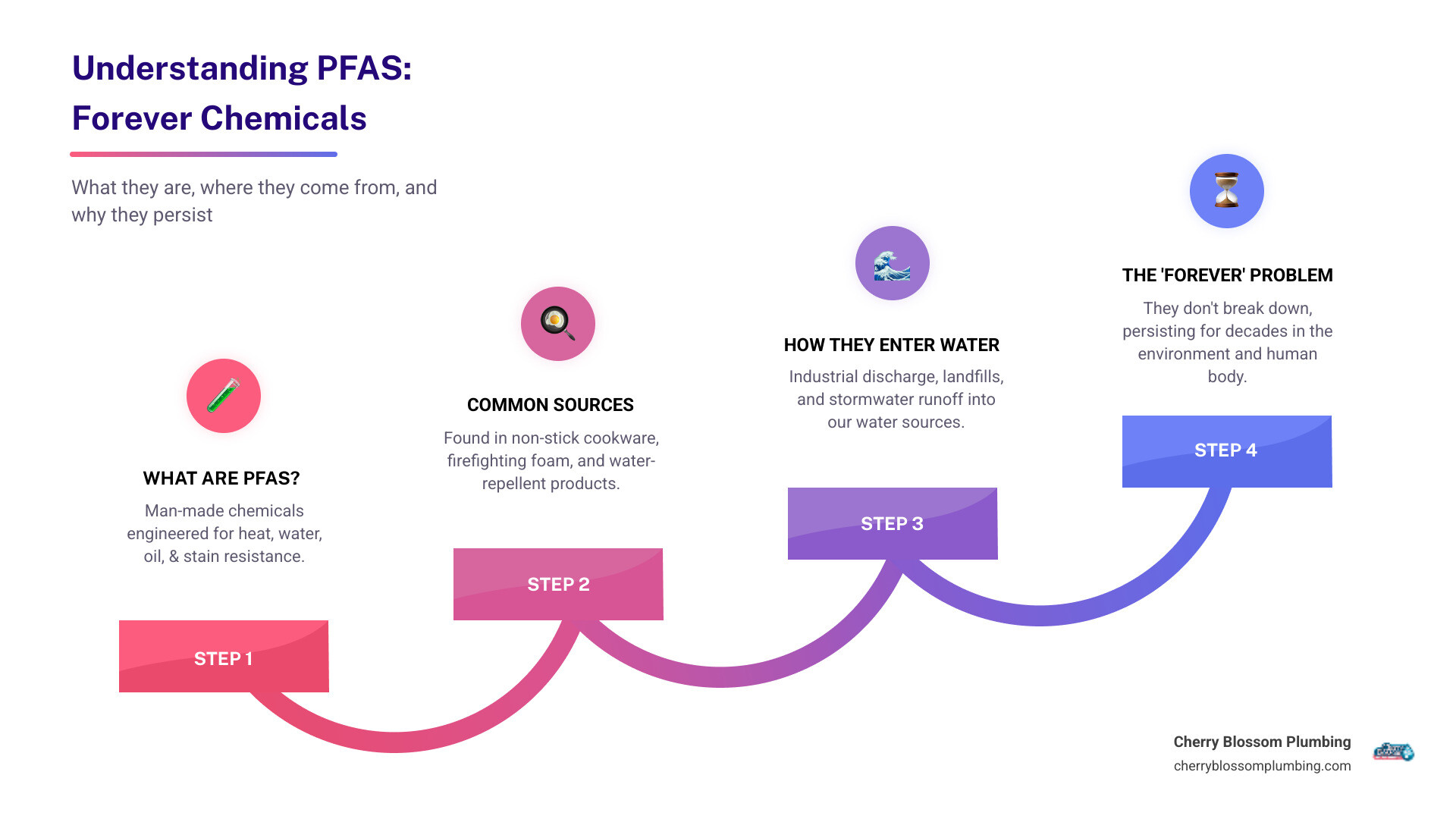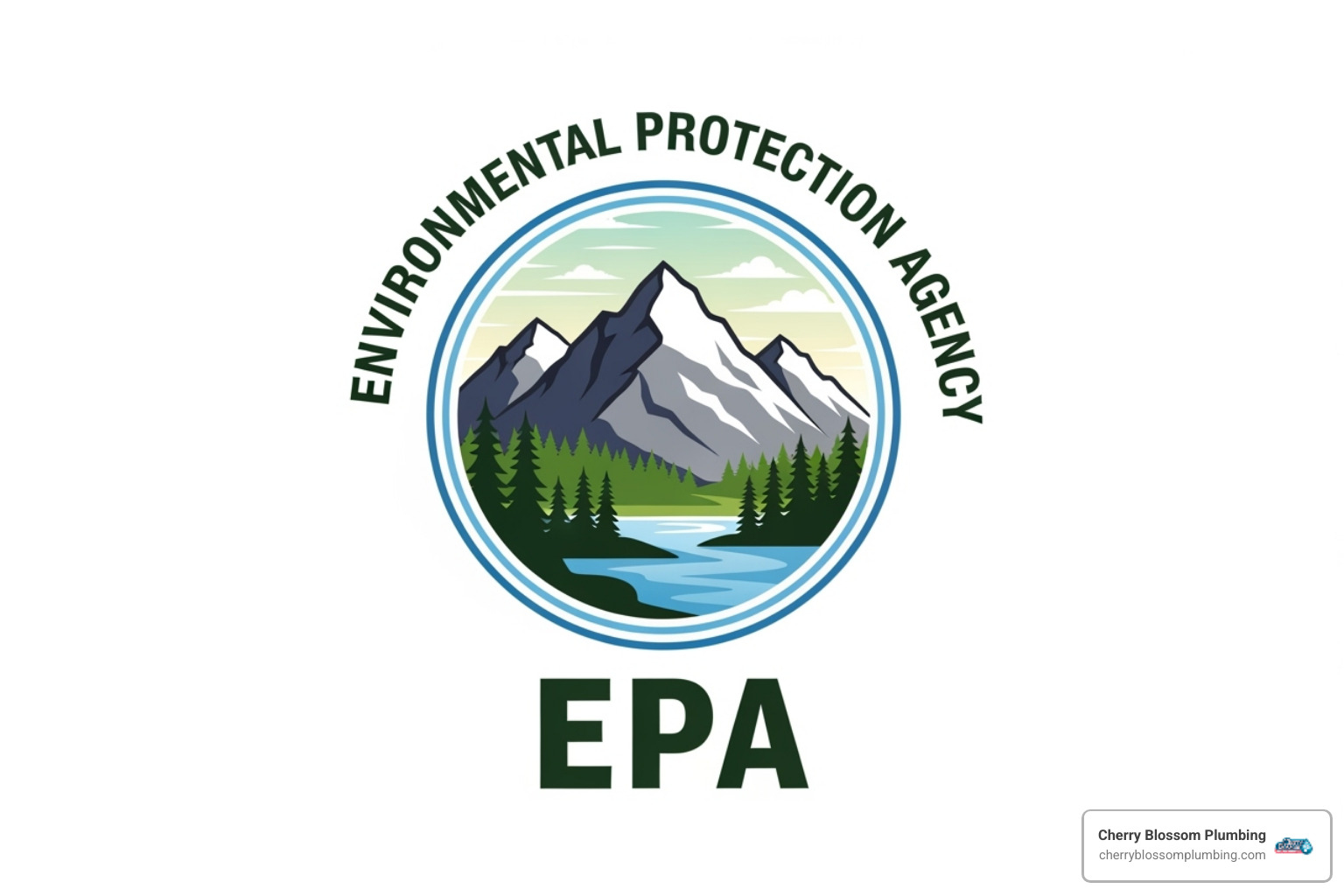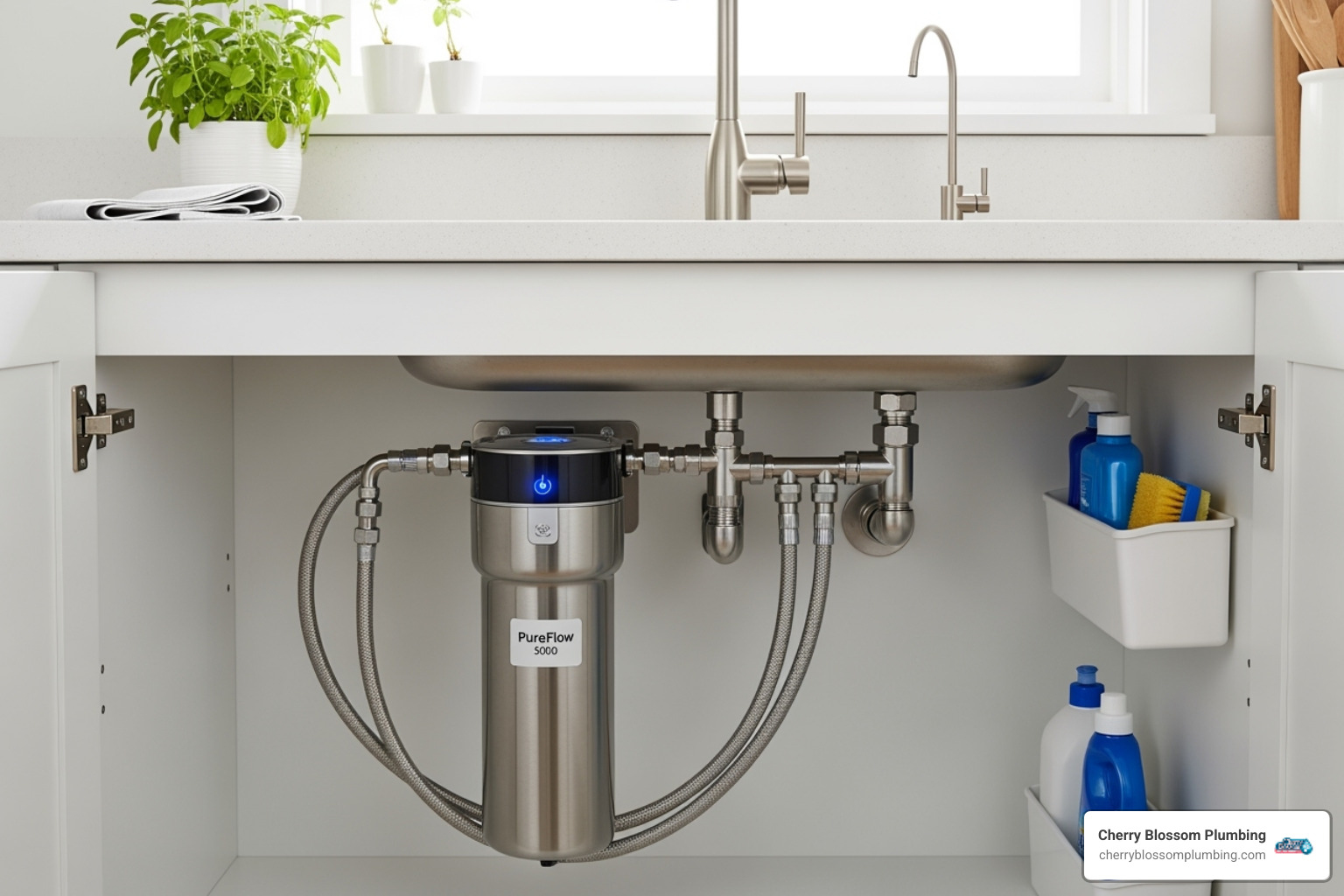
Why Northern Virginia Residents Are Searching for PFAS-Free Drinking Water
PFAS free drinking water northern va is a growing concern for families across Arlington, Fairfax, and Prince William counties. Here's what you need to know right now:
Quick Answer: How to Get PFAS-Free Drinking Water in Northern Virginia
- Check your utility's water quality report - Fairfax Water, Prince William Water, and Arlington County publish annual test results showing PFAS levels
- Install certified filtration - Reverse osmosis (RO) systems, granular activated carbon (GAC) filters, or ion exchange systems effectively remove PFAS
- Test private wells - If you have a private well, contact a Virginia-certified lab for PFAS testing
- Choose point-of-use or whole-house systems - Under-sink filters protect drinking water; whole-house systems treat all water entering your home
In recent years, the phrase "forever chemicals" has dominated headlines across Northern Virginia. These chemicals—formally known as per- and polyfluoroalkyl substances, or PFAS—don't break down naturally in the environment or in your body. They persist for decades, accumulating over time.
The challenge is that PFAS are everywhere. They've been used since the 1940s in products ranging from non-stick cookware to firefighting foam. Now, they're showing up in our drinking water sources, including the Potomac River and Occoquan Reservoir, which serve millions of residents in the region.
Recent testing has revealed concerning findings:
- Prince William Water's East system showed PFOA and PFOS levels slightly above the EPA's new Maximum Contaminant Level (MCL) of 4 parts per trillion
- Virginia Department of Health found PFAS in 15 of 63 samples from 45 waterworks serving the Potomac River and Occoquan Reservoir
- Arlington County's water currently complies with new EPA regulations, but the standards are stricter than ever before
The good news? You don't have to wait for utilities to upgrade their treatment systems. Effective filtration solutions exist right now that can protect your family.
As Amanda Casteel, I've spent years helping Northern Virginia families take control of their water quality, and I'm passionate about debunking the myth that county water is truly "filtered"—in reality, it's chemically treated, and if you don't have a filter, you become the filter. My goal is to help you understand PFAS free drinking water northern va options and make informed decisions about protecting your family's health.

Understanding PFAS in Northern Virginia's Water Supply

When you turn on your tap in Arlington or Fairfax, you probably aren't thinking about chemicals that were invented in the 1940s. But per- and polyfluoroalkyl substances—better known as PFAS—have been quietly making their way into Northern Virginia's water supply for decades.
These man-made chemicals were originally designed to do one thing really well: resist everything. Heat, water, oil, stains—PFAS could repel them all. That's why they ended up in non-stick cookware, firefighting foam, water-repellent products, stain-resistant carpets, and even the grease-proof wrappers around your fast food burger.
The problem? The same properties that made PFAS so useful also make them nearly impossible to get rid of.
Our region's primary drinking water sources—the Potomac River and Occoquan Reservoir—serve millions of residents through utilities like Fairfax Water, Prince William Water, and Arlington County water. And recent studies have confirmed what many suspected: PFAS are present in these waters. The Virginia Department of Health found PFAS in 15 of 63 water samples from 45 waterworks drawing from the Potomac River and Occoquan Reservoir. This isn't just an abstract environmental issue—it's about the water flowing through your home.
Why PFAS Are a "Forever Chemical" Concern
The nickname "forever chemicals" isn't media hype. It's science.
PFAS don't break down in the environment. Not in a year, not in a decade, not even in a thousand years. They persist in our soil, water, and air indefinitely. But here's what makes them even more concerning: they don't just stick around in the environment. They stick around in us.
PFAS bioaccumulate in the human body over time. Each glass of contaminated water, each meal cooked in a non-stick pan, each exposure adds to your body's total burden. And unlike many toxins your body can flush out, PFAS take years to leave your system.
The health risks of PFAS exposure are what keep scientists and health officials up at night. Research has linked liftd PFAS levels to cancer risks—particularly kidney and testicular cancer—along with liver damage that affects how your liver processes toxins. Your immune system can take a hit too, making it harder to fight off infections or respond to vaccines.
For families with young children, the concerns are especially acute. PFAS exposure has been linked to developmental effects in infants, including low birth weight, delayed development, and early puberty. Pregnant women and nursing mothers face particular risks, as these chemicals can pass through the placenta and breast milk.
Other documented effects include thyroid problems, reproductive issues, and liftd cholesterol levels. While a single low-level exposure might not cause immediate harm, it's the long-term, daily exposure through drinking water that poses the real threat.
How PFAS Enter Northern VA's Water
So how do these chemicals end up in our pfas free drinking water northern va sources? Unfortunately, there are multiple pathways.
Industrial discharge has historically been a major contributor. Facilities that manufactured or used PFAS released them into wastewater, which eventually found its way into the Potomac River and other waterways. When old consumer products containing PFAS end up in landfills, these chemicals leach into the ground, contaminating groundwater and eventually surface water.
Airports and military bases represent some of the most significant sources of PFAS contamination. For decades, these facilities used firefighting foam containing PFAS for training exercises and emergency responses. Every time that foam was deployed, PFAS chemicals soaked into the soil and made their way toward our water sources. The Air National Guard and Army National Guard have conducted investigations into their contributions to PFAS contamination in Virginia watersheds.
Wastewater treatment plants, while effective at removing many pollutants, weren't designed to filter out PFAS. So when PFAS from household products and industrial sources enter the sewer system, they often pass right through treatment and get discharged into our rivers and streams.
Even stormwater runoff plays a role. Every time it rains, water washes over contaminated soils, roads, and surfaces, carrying PFAS directly into the Occoquan Reservoir and Potomac River.
Virginia has taken steps to understand the full scope of this problem. The Virginia's Statewide PFAS Sampling Program tracks monitoring efforts across the Commonwealth through an interactive dashboard. The VDH study findings confirm what many Northern Virginia residents suspected: these forever chemicals are already in our regional water supply.
The good news? Understanding where PFAS come from is the first step toward achieving pfas free drinking water northern va. And as we'll explore in the next sections, there are proven ways to protect your family right now—without waiting for utilities to complete expensive upgrades.
The Regulatory Landscape: New EPA Rules and Virginia's Response

For decades, PFAS in drinking water existed in a regulatory gray zone. Water utilities knew these chemicals were present, but without clear federal standards, there was limited guidance on how to address them. That uncertainty ended in 2024 when the federal government took decisive action—and Virginia quickly followed suit with its own initiatives.
If you're looking for pfas free drinking water northern va, understanding these new rules helps explain why local utilities are making changes and why home filtration has become so important for families who want immediate protection.
The EPA's First-Ever National PFAS Standard
On April 10, 2024, the EPA made history by announcing the first-ever national drinking water standard for PFAS. This wasn't just a minor policy update—it fundamentally changed how public water systems across America must handle these forever chemicals.
The new regulations set Maximum Contaminant Levels (MCLs) at incredibly low thresholds. For PFOA and PFOS—two of the most studied and concerning PFAS compounds—the limit is just 4 parts per trillion. To put that in perspective, that's like detecting four drops of water in an Olympic-sized swimming pool. Three additional PFAS chemicals (PFNA, PFHxS, and GenX chemicals) have limits set at 10 parts per trillion.
The EPA also created something called a hazard index for PFAS mixtures. Since we're rarely exposed to just one type of PFAS, this index accounts for the combined health risks when multiple types show up together in your water.
Public water systems now have five years to comply with these new standards. That means utilities serving Northern Virginia—including Fairfax Water, Prince William Water, and Arlington County—must monitor their water regularly and, if levels exceed the limits, install treatment systems to bring PFAS down to acceptable levels.
This compliance timeline matters because it means change is coming, but it's not instant. While utilities work to upgrade their infrastructure, many families are choosing not to wait and are installing home filtration systems now to achieve pfas free drinking water northern va for their households.
How Virginia is Tackling PFAS Contamination
Virginia hasn't been sitting on the sidelines waiting for federal action. Our state government recognized the PFAS threat years ago and has been building its own framework to protect residents. The Virginia Department of Health (VDH) maintains detailed PFAS information and works closely with the Department of Environmental Quality (DEQ) to monitor and reduce contamination.
One of the most significant state actions is the Occoquan Reservoir PFAS Reduction Program, established through House Bill 2050. Starting July 1, 2025, this program specifically targets excessive PFAS levels in drinking water drawn from the Occoquan Reservoir—a critical source for Prince William and Fairfax counties. This isn't just monitoring; it's a dedicated effort to reduce contamination at the source.
Virginia also passed House Bill 2189, which requires certain industrial users to test for PFAS and report their results. This legislation, which took effect July 1, 2023, helps identify where PFAS are entering the water supply in the first place. By tracking contamination back to specific industrial sources, the state can work to stop PFAS before they reach our rivers and reservoirs.
The collaboration between VDH and DEQ has led to comprehensive PFAS assessments across the state. They've even issued fish consumption advisories in some waterways where PFAS levels make it unsafe to regularly eat certain fish species—a reminder that these chemicals affect more than just our drinking water.
These state-level actions complement the new EPA regulations, creating multiple layers of protection. But here's the reality: regulatory compliance takes time, and utility upgrades require significant investment. That's why many Northern Virginia families are taking water quality into their own hands with certified home filtration systems that remove PFAS right now.
Your Guide to Achieving PFAS Free Drinking Water in Northern VA

With new EPA regulations in place and growing awareness about PFAS contamination in our region, many Northern Virginia families are asking themselves: "What can I actually do about this?" The answer is more empowering than you might think. You don't have to wait for utilities to complete their five-year compliance timeline or hope that municipal treatment upgrades will solve everything. There are clear, effective steps you can take right now to ensure your family has truly PFAS free drinking water northern va.
Let me walk you through exactly how to check your current water quality and what proven filtration solutions can protect your home.
How to Check Your Water for PFAS
Before you invest in any water treatment system, it's smart to understand what's actually coming out of your tap. Think of it like getting a diagnosis before starting treatment—you want to know what you're dealing with.
If you're connected to a public water system, your first stop should be your utility's annual Consumer Confidence Report, sometimes called a CCR. Every public water provider is required by law to publish these reports, and they contain detailed information about what contaminants were found in your water and at what levels.
Fairfax Water has been proactive about PFAS monitoring since 2021. Their 2024 report showed that the Griffith Water Treatment Plant, which treats water from the Occoquan Reservoir, had a running annual average for PFOA slightly above the EPA's new Maximum Contaminant Level of 4.0 parts per trillion. If you're in their service area (which covers much of Fairfax County, parts of Loudoun County, and the City of Falls Church), you can find their detailed water quality reports on their website.
Prince William Water has also been testing for PFAS since 2021, and their 2024 UCMR5 testing revealed some important findings. Their East system—serving communities like Woodbridge and Dumfries—showed results slightly above the EPA's MCL for both PFOA and PFOS. Interestingly, their West system, which serves areas like Gainesville and Haymarket, did not detect these compounds at concerning levels. You can find more details on their PFAS page.
Arlington County Water has participated in multiple rounds of PFAS testing, and based on preliminary reviews, their water has complied with the newly released EPA regulations for all six PFAS compounds. Their PFAS overview provides transparency about their ongoing monitoring efforts.
Now, if you're one of the many Northern Virginia residents who rely on a private well—perhaps you live in Great Falls, Oakton, or one of our region's more rural areas—you're responsible for your own water testing. Private wells aren't subject to the same regulatory monitoring as public systems, which means you need to be proactive. Contact the Virginia Department of Health for a list of state-certified laboratories that can test for PFAS. Yes, it's a specialized test and it costs more than basic water testing, but it's the only way to know for certain what's in your water.
Effective Methods for pfas free drinking water northern va
Here's something critical that surprises many people: boiling water does not remove PFAS. In fact, boiling can actually make the problem worse by concentrating these chemicals as the water evaporates. So if you've been boiling your drinking water thinking you're protecting your family from PFAS, unfortunately, that's not helping.
The good news? There are proven filtration technologies that effectively remove PFAS from drinking water. Let me break down the three most effective methods:
Reverse Osmosis (RO) systems are the gold standard for PFAS removal. These systems force water through an extremely fine membrane that captures PFAS molecules along with many other contaminants. RO systems typically remove 90-99% of PFAS, making them incredibly effective. The trade-off is that they also remove beneficial minerals, produce some wastewater, and require periodic membrane replacement. But for PFAS free drinking water northern va, they're hard to beat.
Granular Activated Carbon (GAC) filters work by adsorption—PFAS molecules stick to the carbon surface as water flows through. These filters are effective, though not quite as thorough as reverse osmosis. They're often more affordable and don't produce wastewater, but they do require regular filter changes to maintain effectiveness. As the carbon becomes saturated with contaminants, its ability to capture PFAS decreases.
Ion Exchange systems use special resins that swap out PFAS molecules for harmless ions. These systems can be highly effective for certain types of PFAS, particularly PFOA and PFOS. They're often used in combination with other filtration methods for comprehensive protection.
Here's what you need to know about each approach:
| Filtration Method | Effectiveness for PFAS | Pros | Cons |
|---|---|---|---|
| Reverse Osmosis (RO) | Excellent (90-99% removal) | Removes wide range of contaminants; proven effectiveness; reliable long-term performance | Produces wastewater; removes beneficial minerals; requires professional installation; periodic membrane replacement needed |
| Granular Activated Carbon (GAC) | Good to Excellent (varies by PFAS type) | No wastewater; affordable; improves taste and odor; easy maintenance | Effectiveness decreases over time; requires regular filter changes; less effective for short-chain PFAS |
| Ion Exchange | Very Good (especially for PFOA/PFOS) | Highly effective for specific PFAS; can treat larger volumes; fast flow rates | May not remove all PFAS types; requires resin regeneration or replacement; can be more complex |
For more detailed information about home water treatment options, check out our Guide to Home Water Treatment Systems.
Choosing a Water Filtration Solution for your pfas free drinking water northern va
Now that you understand what works, let's talk about where to install your filtration. You have two main approaches to consider.
Point-of-use (POU) systems treat water at a single location, typically at your kitchen sink. Under-sink filters are the most common POU solution. They're more affordable than whole-house systems, easier to install, and perfect if your primary concern is drinking and cooking water. If you're mainly worried about PFAS exposure through consumption (rather than showering or laundry), a high-quality under-sink reverse osmosis system might be exactly what you need.
Whole-house (point-of-entry or POE) systems treat all the water coming into your home. These are installed at your main water line and ensure that every faucet, shower, and appliance receives filtered water. While they're a bigger investment upfront, they provide comprehensive protection and peace of mind. If you have children who might drink from bathroom sinks or you're concerned about PFAS exposure through showering (there's some research suggesting dermal absorption and inhalation of water vapor), a whole-house system makes sense.
When you're shopping for any PFAS filtration system, look for NSF certification. NSF International is an independent organization that tests and certifies water treatment products. Specifically, you want to see NSF/ANSI Standard 53 or 58 certification for PFAS reduction. This certification means the system has been independently tested and proven to reduce PFAS to safe levels.
At Cherry Blossom Plumbing, we specialize in Water Filtration Northern VA solutions custom to our region's specific water quality challenges. We've helped hundreds of Northern Virginia families achieve pfas free drinking water northern va through properly sized and installed filtration systems. For a comprehensive look at your options, read our PFAS Removal System Northern VA Guide.
The reality is that choosing the right filtration system isn't a one-size-fits-all decision. It depends on your water test results, your family's water usage, your budget, and whether you're on public water or a private well. But here's what I can tell you with confidence: effective solutions exist, they're more affordable than most people think, and you don't have to wait years for utility companies to act. You can take control of your family's water quality today.
Customer Testimonials
Cherry Blossom Plumbing has consistently provided top-notch service, ensuring every issue is resolved efficiently and professionally.







